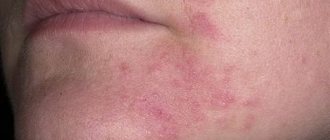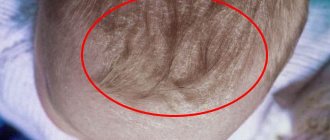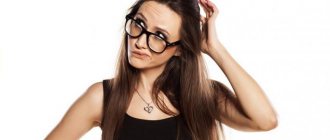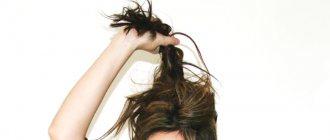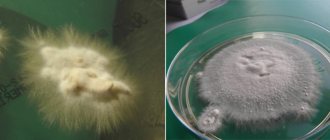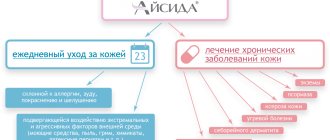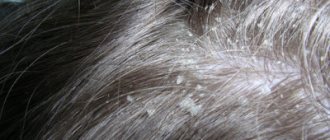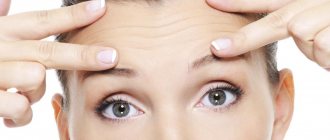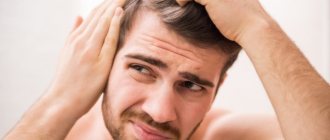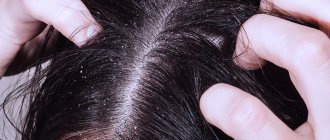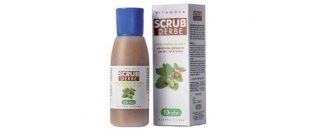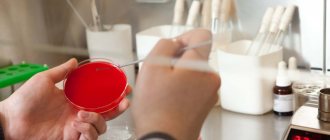- about the author
- VK profile
Svetlana Tarasova
Hairdresser-stylist with more than 8 years of experience, expert in the field of haircuts, styling, hair care, coloring.
The main complaints of patients with seborrhea are itching, peeling and thickening of the stratum corneum. To eliminate them, special means are used. Seborrhea ointment is aimed at eliminating the causes of the disease and combating unpleasant symptoms.
What is seborrheic dermatitis on the scalp?
In the modern world there are hardly people who do not know what this symptom is - dandruff. Seborrhea is a non-infectious skin disease that affects those areas of the epithelium where the largest number of secretory glands are located. The sebum produced by the glands changes its composition and consistency, becoming viscous. The modified composition of sebum becomes a breeding ground for the proliferation of harmful microorganisms. Disruption of the sebaceous hair follicles leads to the active synthesis of opportunistic fungi of the genus Malassezia Pityrosporum ovale, under the influence of which intensive exfoliation of the stratum corneum occurs.
Causes
Seborrhea often develops against the background of serious hormonal imbalances in the body. According to experts, it is men who most often face the unpleasant consequences of the disease. This is because in representatives of the stronger sex, the sebaceous glands work more actively due to the high level of testosterone in the blood. In addition to disruption of the endocrine system, there are 8 more main factors that provoke the development of dermatitis. These include:
- genetic predisposition;
- the predominance of fatty, sweet and spicy foods in the diet;
- dysbacteriosis;
- hypovitaminosis;
- hyperhidrosis (excessive sweating);
- failure to comply with hygiene rules;
- allergic reaction;
- constant stress.
In addition, seborrheic dermatitis can result from diseases such as:
- epilepsy;
- Parkinson's disease;
- Immune system disorders (AIDS, HIV).
Symptoms and manifestations
The first main manifestation of the disease in both men and women is dandruff, which is formed due to intense exfoliation of the scalp. If in a healthy person the process of exfoliation of dead cells occurs over the course of 1-2 months, then in patients with seborrhea, under the influence of the fungus, the skin is renewed every 5-7 days.
In men
Representatives of the stronger sex are faced with a mixed type of seborrheic dermatitis. Excessive oily skin is a consequence of increased levels of androgens in the body, against which the development of seborrhea occurs. In addition to intense exfoliation of epithelial particles on the scalp, men may also experience the following symptoms:
- redness of areas of the epidermis affected by the fungus;
- feeling of itching, burning;
- excoriation;
- excess oiliness of the skin;
- intense hair loss.
Among women
Manifestations of the disease may not be so pronounced; women often experience symptoms such as:
- rapid greasiness of hair roots (with oily type);
- the presence of small epithelial scales;
- increased dryness of the skin, the presence of peeling (in the dry form of the disease).
In teenagers
During puberty, adolescents undergo serious hormonal changes in the body. The predominance of male hormones provokes the development of seborrheic dermatitis, and also contributes to the appearance of other, no less pleasant consequences in the form of increased sweating and acne. In adolescents, as in adults, in addition to dandruff, a number of symptoms are diagnosed, among which the following are worth highlighting:
- thickening of inflamed skin areas;
- excess hair greasiness;
- presence of bleeding wounds.
In the absence of timely treatment, inflammatory changes are localized in areas of the skin near the hairline, above the eyebrows, and behind the ears.
What does it look like
The favorite place for localization of seborrhea is the skin of the face and scalp. Foci of inflammation affect areas of the body where a large number of sebaceous glands are located. Scaly plaques covered with white flakes have a yellowish tint. In severe cases, the inflamed areas of the skin begin to bleed, cracks and pustules appear. In rare cases, a gray crust with an unpleasant odor forms on the surface of the plaques.
Causes of the disease
Dermatitis has a multifactorial origin. It is known that the presence of a fungal infection in the body is not a prerequisite for the development of the disease. Dermatitis is a multifactorial disease that occurs in the presence of several provoking factors.
These include:
- decreased immunity;
- hormonal disorders;
- hereditary predisposition;
- violations of hygiene standards;
- presence of chronic infectious diseases;
- use of cosmetics containing components harmful to the epidermis;
- systematic use of hats made of synthetic materials;
- prolonged exposure to sunlight on the scalp;
- bad habits;
- stress loads on the body;
- vitamin deficiency.
Atopic dermatitis on the head occurs mainly in children aged 2-7 years. This is explained by the increased sensitivity of the child’s body to various types of allergens, as well as reduced immunity compared to adults. Dermatitis can occur against the background of concomitant diseases, especially of the digestive system.
When scalp dermatitis occurs, it is extremely important to determine the cause of the disease. Elimination of the provoking factor in most cases allows you to get rid of the disease in a short period of time.
Kinds
There are 6 types of seborrheic dermatitis:
Dry
Characterized by the presence of itchy peeling that affects the parietal and occipital part of the head. The sebaceous glands do not produce enough secretion. As a result, the natural pH level of the skin is disrupted. The boundaries of fungal damage are unclear, particles of the epithelium have a grayish tint and crumble when combing the strands.
Fatty
A distinctive feature is increased sebum production. The sebum of the skin glues together the yellow scales of the epithelium, forming seals. When combing, the dandruff comes off in large flakes. Washed hair quickly loses its freshness due to excessive activity of the secretory glands.
Contact
Develops after direct contact of the scalp with a physical or chemical irritant. As a rule, the contact form of seborrhea is provoked by cosmetics that contain aggressive cleansing components. The disease is accompanied by swelling, redness and peeling of the damaged areas, as well as an unpleasant burning sensation.
Weeping, itchy
Damaged areas of the epidermis are covered with a serous-purulent crust. Weeping wounds form at the site of inflammation and cracks. Subsequently, the disease leads to alopecia areata.
Atopic
This type of dermatitis has a more pronounced clinical picture. The patient experiences severe itching, burning, and blisters appear on the surface of the scalp; an elevated body temperature may be observed. Atopic seborrheic dermatitis is the result of a severe allergic reaction. Individual intolerance can be triggered by both food and incorrectly selected hair cosmetics.
Chronic
Lack of treatment contributes to the transition of the disease to a chronic form. This type of dermatitis is the most difficult to respond to drug therapy. In advanced stages, seborrhea provokes intense hair loss. The chronic course of the disease is characterized by a state of remission, when the symptoms are mild. However, during an exacerbation, a relapse of the disease occurs, which is characterized by itching, burning, and the formation of inflamed plaques and ulcers.
Symptoms of seborrhea of the scalp
Even children are susceptible to this disease, so it is very important to know the first symptoms of the pathology in order to consult a doctor in time and not start the process. To accurately diagnose the disease, it is recommended to undergo the necessary tests, on the basis of which effective treatment will be prescribed. You need to understand that the symptoms of oily and dry seborrhea vary greatly, which should also be taken into account when making a diagnosis.
Speaking about the dry type of seborrhea, it is distinguished by the following symptoms:
- itching;
- thinning, dull appearance, hair loss and severe fragility;
- the appearance of dandruff resembling small scales;
- tightness and dryness of the scalp.
Failure to identify the problem in a timely manner can lead to a pathology such as seborrhea alopecia. The worst thing about this disease is that the hair begins to fall out and it is unlikely that it will be possible to restore it even over time, since there is no vegetation in the areas of bald spots.
During oily seborrhea, a person experiences symptoms such as:
- severe itching;
- oily scalp and greasy hair;
- yellowish, red or pink spots appear;
- the hairstyle gets dirty very quickly, it immediately takes on an unkempt, unkempt appearance;
- large dandruff flakes off in crusts.
At the initial stage of oily seborrhea, the scalp is covered with small yellow nodules. Over time, the diameter of the nodules begins to increase, they merge and form some kind of plaques, large large foci of dermatitis. During this period, a feeling of itching appears, the skin becomes very oily, if seborrhea is in an advanced stage, then the disease spreads to the nearest areas - nasolabial folds, eyebrows, the area behind the ears and forehead.
As a result of this disease, a person develops inflamed, itchy crusts, sticky strands, and hair may fall out, even to complete baldness. You can cope with this disease at any stage; the main thing in this case is to consult a doctor in a timely manner and choose an effective treatment against seborrhea.
Drug treatment
Medicines for dandruff are based on antifungal components with a fungicidal effect, as well as substances with drying, regenerating and wound-healing properties. How to cure seborrhea quickly and effectively:
Ointments and creams
At the initial stage of the disease, trichologists advise using special antifungal lotions, ointments and creams. Using rubbing movements, apply the product to damaged areas of the epidermis 1-2 times a day. The effectiveness of such drugs is due to the fact that the composition remains on the skin for a long period of time. Among the effective ones, it is worth highlighting the following means:
Sulsena paste
A budget drug for dandruff, the cost of which does not exceed 150 rubles. The main active ingredient is selenium disulfide, which has a powerful bactericidal effect. It is recommended to use the product in combination with shampoo from the same line. Pharmacies offer two types of paste - 1% and 2%. Sulsena 2% is used to treat seborrheic dermatitis. The first version of the drug was developed for the purpose of prevention and is used after getting rid of the unpleasant symptoms of seborrhea.
Price – about 100 rubles
Triderm
An antifungal ointment containing betamethasone, gentamicin and clotrimazole. The combined combination of these substances helps to destroy yeast fungi, and also relieves itching and irritation. The drug is active against gram-negative bacteria. A thin layer of ointment is applied to the affected areas of the skin twice a day - morning and evening. The minimum cost of the drug is 669 rubles for 15 g.
Mustela
Mustela Stelaker cream is sold in 40 ml tubes with a screw cap at a price of 850 rubles. Liquid consistency without a pronounced aroma spreads easily over the skin. For convenience, the tube is equipped with a thin spout, with which you can easily apply the product to the root part of your hair. The reduction in the production of sebaceous glands occurs due to the aloe vera powder contained in it. Hypoallergenic cream for seborrheic crusts is suitable for the treatment of newborns.
Akriderm
The hormonal remedy is intended for the treatment of seborrheic dermatitis, eczema and psoriasis. The ointment is based on betamethasone dipropionate, characterized by anti-inflammatory and bactericidal effects. The product is intended for external use and does not require rinsing. Only the areas of skin affected by seborrhea are treated with a thin layer of ointment. The price varies from 95 to 673 rubles per 30 g.
Belosalik
The lotion formula is also developed on the basis of betamethasone dipropionate, which has an antifungal, keratolytic and antihistamine effect on the affected areas of the epithelium. The composition also contains salicylic acid, which has a pronounced exfoliating effect.
Cost – about 400 rubles
The bottle with a convenient spray nozzle must be shaken thoroughly before use. The product is sprayed onto the skin 2 times a day. The minimum cost is 366 rubles per 20 ml.
Medicines based on corticosteroid hormones are allowed to be used with the permission of the attending physician.
Shampoos
Anti-dandruff shampoos are based on substances with bactericidal and exfoliating properties. These include salicylic acid, ketoconazole, zinc pyrithione, selenium disulfide, tar, tea tree oil, citric acid. The cleanser is used 2-3 times a week, and for the purpose of prevention, shampoo is used no more than once a week. The duration of therapy depends on the severity of the clinical picture, as well as the degree and form of the disease. As a rule, the treatment course is 1-2 months. There are 2 effective shampoos against dermatitis:
Nizoral
The main component is ketoconazole, which has a powerful antifungal effect. The drug is prescribed for the treatment of dandruff, eczema, psoriasis and pityriasis versicolor. The product eliminates itching, flaking, and also prevents hair follicles from falling out. Suitable for all hair types. Price – 696 rubles for a 60 ml bottle.
Sebozol
The formula of the product is based on ketoconazole. The drug has a regenerating, sebostatic, anti-inflammatory effect, and also prevents the proliferation of yeast fungi. The manufacturer recommends washing your hair with shampoo no more than 2 times a week for a month. A 200 ml bottle is sold at a price starting from 453 rubles.
Price – about 450 rubles
Pills
The best results in the fight against dandruff are demonstrated by complex treatment, when topical agents are combined with oral medications. Drugs in tablet form should have an antifungal and antihistamine effect. Among the medicines presented in the pharmacy, there are two effective remedies:
Metronidazole
An antimicrobial drug, the cost of which does not exceed 200 rubles. The tablets are active against yeast fungi of the genus Malassezia and relieve the patient of unpleasant symptoms such as itching and burning.
Fluconazole
An antifungal drug of the triazole class has pronounced anti-inflammatory and antihistamine properties. Eliminates swelling of the affected areas, restores the body's protective functions. The cost for 4 capsules of 150 mg is 93 rubles.
Vitamins
Often, white flakes on the scalp signal a deficiency of certain vitamins and microelements in the body. Exacerbations of hypovitaminosis occur in the autumn-spring period. When treating seborrheic dermatitis, experts prescribe a complex of substances such as:
- Ascorbic acid - helps strengthen the immune system, starts the process of renewal of epidermal cells.
- Folic acid - normalizes hormonal levels in the body, is useful for women, as it promotes the production of estrogen.
- Vitamin A or retinol - regulates the production of sebaceous glands, making hair smooth and elastic.
- Riboflavin and vitamin B12 help strengthen weakened bulbs and prevent peeling of the skin.
- Zinc - reduces the activity of the sebaceous glands, normalizes the natural pH level of the skin.
Costs from 20 rubles
Hair mask at home
For those who do not know how to get rid of seborrheic dermatitis, we recommend using a simple homemade mask recipe. You can make an effective anti-dandruff remedy yourself without spending a significant amount of money. All you need for the mask is acetylsalicylic acid (aspirin), egg white and a few drops of eucalyptus essential oil.
Aspirin tablets (4 pcs.) are first crushed to a powder, after which the acid is combined with egg white. At the very end, add essential oil. The resulting mixture is rubbed into the skin with massage movements and left for 5-10 minutes. Next, the head is thoroughly washed using shampoo.
Types of ointments and rules of use
Local treatment of the disease can be carried out with ointments with different effects. There are 5 main types of funds:
- antihistamines: aimed at reducing itching, redness and swelling of the skin;
- antimycotic: destroy pathogenic fungi that cause inflammation;
- regenerating: promote accelerated healing of affected areas;
- immunostimulating: aimed at activating local immunity and protective properties of the skin;
- antibacterial: used in patients with bacterial microflora.
Therapy includes the prescription of both single-component and combined medications that have a complex effect on inflammation of the skin.
Antibacterial
Ointments with an antibacterial effect are recommended by a dermatologist for seborrheic dermatitis complicated by inflammation of bacterial etiology. Medicines destroy microbes and help prevent the formation of ulcers. They require a full course of therapy, even when the acute symptoms of the disease have disappeared.
Note! If the patient stops using the product prematurely, the manifestations of the pathology may return.
Antifungal
Antimycotics are used to suppress the development of pathogenic fungi that have begun the inflammatory process in the skin. The principle of action is to disrupt metabolic processes and destroy cell membranes. This leads to the death of damaged cells.
Antifungal ointments are prescribed in long courses of up to 6 weeks. After completing the course of therapy, the dermatologist refers the patient for diagnostics to determine the effectiveness of the antimycotic.
Regenerating and strengthening
Such ointments are aimed at quickly restoring the skin after the causative agent of the disease has been destroyed. includes strengthening and restoring components. They reduce the amount of inflammation, eliminate redness, and fight burning and itching.
Features of use during pregnancy and lactation
During pregnancy, the doctor does not prescribe hormonal ointments for seborrhea. Antifungal and antibacterial drugs are prescribed individually depending on the gestational age and the characteristics of the mother. A small concentration of the active components of the product still penetrates the woman’s bloodstream and milk, which can cause various complications in the child.
Folk remedies
Time-tested traditional methods of treatment in combination with medicinal medications give a stable therapeutic result. And in some cases, the old “old-fashioned” methods turn out to be more effective than expensive purchased products.
Castor oil
Oil mixtures are recommended for use in the treatment of dry seborrheic dermatitis. Otherwise, the oil will provoke even greater activity of the secretory glands. Pharmaceutical castor oil is made from castor bean seeds. The product is enriched with a high concentration of ricinoleic acid, which boasts antiseptic and anti-inflammatory properties.
Vitamin E included in the composition moisturizes damaged skin areas and relieves inflammation. It is recommended to mix the product with other light oils, such as jojoba, grape or peach seed. The mixture, slightly heated in a water bath, is applied to the scalp, and after 2 hours the head is washed with shampoo.
Price – about 80 rubles
Soda
Regular baking soda, diluted with burdock or olive oil, not only eliminates dandruff, but also prevents intense hair loss. 2 teaspoons of soda are poured with enough purified water to form a thick paste. Then add a tablespoon of base oil. A soda-based mask exfoliates the stratum corneum, thus eliminating small epithelial scales. At the same time, this scrub acts delicately and does not damage sensitive areas of the skin.
Tar soap
Of particular value is the birch tar contained in the soap, which destroys pathogenic fungal infections. Tar soap will be effective in the treatment of oily seborrhea. It will remove excess fat, reduce the greasiness of the skin, and prolong the cleanliness of washed curls. The soap bar is first foamed in your hands, after which the resulting foam is rubbed into the skin with massage movements. After the cleansing procedure, you must apply any nourishing mask or balm to your hair.
Tea tree oil
Concentrated ether has disinfecting, bactericidal and anti-inflammatory effects.
Essential oils should never be applied to the scalp in their pure form. High concentrations of active substances can cause serious burns.
Tea tree oil can be added to various masks, balms and shampoos, but those with dry, sensitive scalps should not use the product. Before application, be sure to test to identify an allergic reaction.
Contraindications
Topical medications should not be used for the following conditions:
- open wound in the area of application;
- infection of the skin with bacterial or viral pathogens;
- gestational and lactation periods;
- the presence of severe concomitant somatic diseases;
- immunodeficiency states.
Important! Before using the drug, you should consult a dermatologist. The doctor will recommend a suitable ointment and its concentration and may advise an alternative remedy if there are contraindications.
What to do if it doesn't work
The success of therapy depends on the extent of skin damage by yeast fungus. A mild form of the disease can easily be treated locally. Advanced stages of seborrhea require competent combination treatment, which will include both the use of local remedies and internal administration of antifungal and antihistamine medications.
If treatment does not bring any results, the patient should seek help from a dermatologist or trichologist as soon as possible. Based on the patient’s tests, the doctor will identify the cause of the disease and prescribe appropriate therapy.
Advantages and disadvantages
When a patient suffering from seborrhea chooses an ointment to treat the disease, he should become familiar with the advantages and disadvantages of the dosage form. The main advantages of this tool:
- ease of use: can be used at home;
- quick effect - the formation of sebaceous gland secretions is normalized;
- one package is enough for the entire course of therapy;
- no effect on internal organs: the active component is not absorbed into the bloodstream in high concentrations;
- wide selection of products;
- opportunity to buy the drug at any pharmacy.
The disadvantages of seborrhea ointment are:
- the medication has a drying effect, which negatively affects the skin;
- does not affect the cause of the disease, fights only its symptoms;
- ineffective for severe pathology;
- the result obtained lasts for a short time;
- presence of a large list of contraindications.
Can seborrheic dermatitis of the scalp be cured forever?
Very often people are interested in the question: is it possible to cure seborrhea forever; unfortunately, it is impossible to get rid of dandruff once and for all, since the development of the disease can be triggered by a wide variety of factors. Those people who have encountered dermatitis at least once in their lives need to maintain a certain lifestyle, avoid stress, and not abuse alcohol, spicy and fatty foods.
Not even one expensive drug can cure seborrheic dermatitis once and for all. All the manufacturer’s promises are nothing more than a marketing ploy that promotes effective sales of products.
Shampoo for dermatitis - reviews of medications
Reviews of shampoos for seborrheic and atopic dermatitis vary; some drugs have a high effect and good protection against relapse, others relieve symptoms only temporarily, others have no effect and can even increase symptoms if used incorrectly.
Natalia, 33 years old, Khanty-Mansiysk
For treatment, I have long been using shampoos for atopic dermatitis with natural composition, I especially like those with tar. Although they often have a strong and unpleasant smell, I got used to them. About six months ago I took a course of using Algopix shampoo. I note that it quite effectively relieved peeling and itching.
Irina, 41 years old, Semipalatinsk
I have a very problematic scalp. One of the shampoos that I really liked is Etrivex. My daughter also develops seborrhea, most likely due to heredity, but she cannot use Etrivex because she is not yet eighteen. The doctor chose another remedy for my daughter. Etrivex perfectly removes peeling, itching, and inflammation. I recommend to everyone.
Restoring lost hair after seborrheic dermatitis
Constantly crumbling epithelial particles in advanced cases lead to pityriasis-like peeling of the skin and, as a result, further hair loss. At the initial stage, the bulbs fall out in small quantities. However, over time, the situation worsens and visible bald spots form on the head. It is impossible to restore the density of curls on damaged areas of the head. That is why it is important to prevent the disease from worsening.
You can strengthen your hair after oily seborrhea with the help of masks with an intense warming effect, which contain pepper, cinnamon, ginger, mustard or Bay oil. For those with dry skin, it is recommended to rub in a mixture of burdock, olive and castor oils to restore hair.
In what cases are ointments prescribed?
Local remedies for seborrhea are indicated if the following symptoms are present:
- the formation of papules and plaques on the skin that are red and covered with scales;
- dandruff with hair loss in the affected area;
- the appearance of skin peeling in areas of inflammation;
- increased prevalence of rash;
- severe itching;
- the appearance of pain in inflammatory foci.
Ointments are selected strictly taking into account the form and severity of the pathology.
How to make homemade shampoo
Sometimes you don’t even suspect that in the kitchen or in the refrigerator there is a whole pharmacy of folk remedies or, at a minimum, components from which you can quickly prepare homemade shampoo. Excellent folk remedies for treating seborrheic dermatitis are homemade shampoos.
The effectiveness of treatment increases many times over if complex treatment of seborrheic dermatitis is used. It is necessary to combine traditional and official medicine.
Here are some recipes:
- Egg shampoo. Method of preparation: separate 2 yolks, beat them thoroughly with 1 glass of warm water. Moisten the hair roots well and rub until foaming. Then wash with running water. A fresh mixture is prepared every time. This shampoo is not prepared for future use.
- Kefir. You can use store-bought low-fat kefir as a homemade shampoo. It is good to moisten the hair roots with it, massage with light movements, then rinse with running water.
- Shampoo with homemade yogurt. Used for dermatitis on dry hair, regardless of the degree of dermatitis. Method of preparation: boil 50 g of crushed oak bark in 0.5 liters of water for a quarter of an hour, let it brew to obtain a strong, rich decoction. Strain, mix thoroughly with 1 liter of homemade “skimmed” yogurt. After washing, do not degrease your hair, leave it in this condition for some time. This shampoo can be stored in the refrigerator for a week if you plan to wash your hair daily.
Treatment of seborrheic dermatitis with lotions, wraps, and rinsing with herbal infusions is allowed today. These methods are used by dermatologists, trichologists, and cosmetologists. Recipes are even used in the treatment of young children, in whom seborrhea becomes a complication of allergies. But one important principle remains: the combination of traditional treatment with taking medications.
